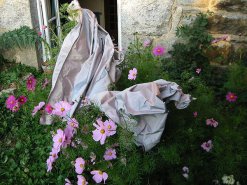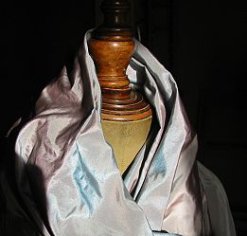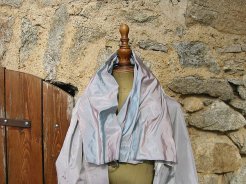- Home
- Resurrection ▾
-
Learn ▾
- Free library
- Glossary
- Documents
- Initiation
-
Shaped fabrics
- Introduction
- Popularization
- Definitions
- Le métier de façonné
- Principes du façonné
- Mécaniques de façonné
- Le jeu des crochets
- Les cartons
- Chaîne des cartons
- Mécanique 104 en détail
- Pour en finir
- Montage façonné
- Empoutage 1/3
- Empoutage 2/3
- Empoutage 3/3
- Punching, hanging and dip
- Autres façonnés
- Façonnés et Islam
-
Cours de tissage 1912
- Bâti d'un métier
- Le rouleau arrière
- Les bascules
- Formation du pas
- Position de organes
- Mécanique 104 Jacquard
- Fonctionnement 104
- Lisage des cartons
- Le battant du métier
- Le régulateur
- Réduction et régulateur
- Mise au métier d'une chaîne
- Mise en route du métier
- Navettes à soie
- Battage
- Ourdissage mécanique
- Préparation chaînes et trames
- Equipment ▾
- Chronicles ▾
- Fabrics ▾
- Techniques ▾
- Culture ▾
- Language ▾

The Chameleon Taffeta

In our opinion, this fabric, the simplest in its design is also one of the most difficult to succeed.It is a true mirror, the slightest irregularity takes catastrophic proportions. It requires a great many precautions, a perfect regularity and a good experience of its practice. If it is no longer true for a large part of the fabrics, here the hand-weaving undoubtedly shows a superiority to mechanical weaving (and that is why we have chosen to produce them).
Chameleon taffeta requires:
- perfect reeling
- perfect duvet
- cans of the same size
- high chain tension
- good braking of the frames
- a rising and falling system
- the use of 6 frames and an amagalmé
- the use of a regulator
- the use of a walker (the leaf is not touched)
- a soft and cushioned launch of the shuttle
- a chameleon shuttle

The Chameleon Taffeta
Perhaps you had never heard of chameleon taffetas before discovering this site. Normal, first of all because this fabric is not manufactured for a long time, and then because we are in love with this fabric and we do not miss an opportunity to talk about it ...

But let us begin by defining this fabric, for all those who do not yet know the silks.
Taffetas is the word used in silk to designate a fabric weave fabric, a thread caught, a thread left.It used to be used to designate silk fabrics, but for synthetic yarns it has been used for a hundred years, it also designates canvas fabrics made of these materials.
As a result, taffeta does not necessarily involve silk, it's good to know.
In digression, we have often remarked how certain errors of terminology have given rise to nonsense which has become widespread and has a tough life. One of the best examples is satin.Satin is an armor, a way of interlacing threads, so it can be made of silk, cotton, linen or any material just like a canvas or a twill can be too.I read hundreds of times, on the Internet, in magazines or in books of literature of the mentions of the kind:
"Silk or satin dresses ..."
As if satin was a matter. A real confusion ...
But let us return to our sheep, or rather to our silkworms.
Taffetas, a silk fabric, have certainly been the most fabricated silk fabric, for clothing, for upholstery, or for utility fabrics. A very large number of taffetas had a commercial designation to differentiate this fabric according to its quality, its use or the type of silk yarn that made it.
Either the taffeta is a silk canvas. And we understand that according to its quality and composition, it bears one name or another. I will personally be more restrictive (this only binds me) and will define taffeta as a woven cloth weave fabric with a chain and an organsin weft.
Let's go, but what is the organsin?
The organsin is formed of two (sometimes three or more) hair yarns twisted separately in straight torsion (Z), then twisted together in left torsion (S). The torsion S is 500 to 600 turns per meter, the torsion Z varying according to the destination of the organsin: 300 rpm for the velvet yarns, 400 rpm for the satins and 500 for the taffetas. The more turns are given, the less the wire is shiny and the stronger it is. The organsin is mostly used for the warp.(To know more about the different silk threads).
The organsin is thus par excellence the string of silk fabrics and therefore taffeta.
For those who like old-fashioned fabrics, it can be said that silk taffeta is a concrete characteristic, this is recognized by all, by a very special touch that has no other fabric. Everyone has heard of the screeching of silk that is handled. When you touch a beautiful silk taffeta, this sensation in the fingers remains unforgettable. An old-fashioned taffeta has a "map", that is to say that when it is shaken or shaken, the touch and the noise are those of a sheet of tracing paper.
The old-fashioned taffeta has this peculiarity of using organsin in weft thread, and this is what gives it this "card".
And the famous chameleon taffeta, what is it?
Here we touch on a delicate point of terminology:If we speak of taffeta chameleon, we speak first of changing taffeta. In a generic way, a changing taffeta is a taffeta whose appearance changes according to the angle at which it receives light: it changes color.
In the changing taffeta, we find:
1- Taffeta glazed: the chain is one color and the weft of another color.This is enough to give him this changing aspect.
2- Taffetas called "chameleon": the changing aspect is even stronger, it is composed not of two colors, but of three.This is where the polemic can be established. Because chameleon taffetas were first woven by hand. Then, from about 1890 onwards, industry sought to manufacture these fabrics in the mechanical craft, without ever succeeding in crossing the pitfalls which were nevertheless overcome by the hand of man, that intelligent hand which differentiated it from the cams and the motors. The industry has therefore "adapted" this technique to obtain a fabric whose effect approaches that of the hand woven chameleon.Thus, a string composed of, for example, a blue thread, a green thread, etc., has been used. In short, the warp has been entrusted with the work of the frame. And the frame used was only one Single color.As far as we are concerned, this fabric is a taffeta changing quality much lower, but not a chameleon.
In chameleon taffeta woven by hand, the true one uses a warp of a single color and a special shuttle, called "chameleon shuttle", is used which comprises two cans of different colors, the sequence of which is braked individually on each of the two frames. In fact, it is imperative that the two threads be laid stretched in the crowd without ever touching, so as to be rigorously parallel when packed.